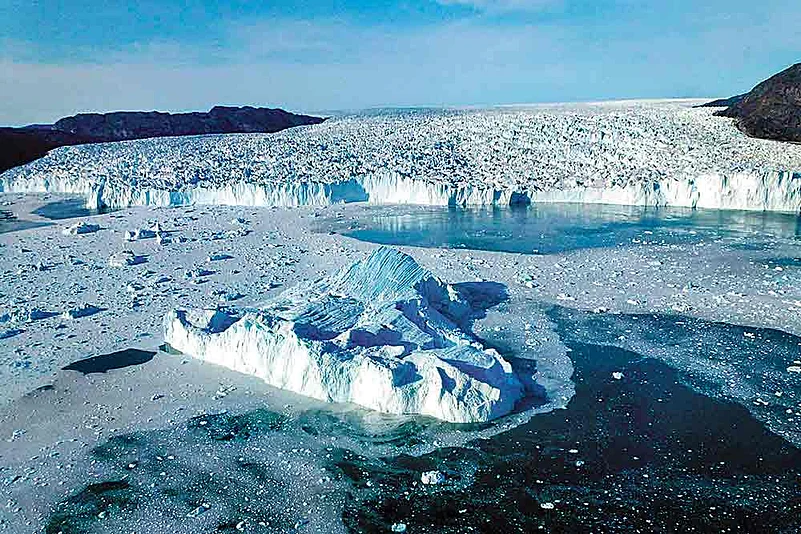We are in the midst of an ice age. The reason we still survive is that fortunately an ice age, which can last for a period between tens of millions to hundreds of millions of years, alternates between glacial and interglacial periods. During the glacial phase, the ice sheets advance, as they retreat during the interglacial one. According to www.universetoday.com, “The Earth is currently in an interglacial period, and the last glacial period ended about 100,000 years ago. What remains of the continental ice sheets that once stretched across the globe are now restricted to Greenland and Antarctica, as well as smaller glaciers — like the one that covers Baffin Island.”
In our planet’s history, we have witnessed five ice ages. The first one lasted 2.4-2.1 billion years ago, and evidence was found around Lake Huron. The second one, 850-630 million years ago, was “perhaps the most severe.” According to the website, “It is believed that during this period, the glacial ice sheets reached the equator, thus leading to a ‘Snowball Earth’ scenario.” The third, 460-420 million years ago, was traced through evidence in Andean and Sahara regions. The fourth, 360-260 million years ago, caused a long-term increase in oxygen levels and reduction in carbon dioxide, which led to global cooling, the exact opposite of what we witnessed over the past couple of centuries. The fifth started 2.5 million years ago, and is ongoing. There are several theories to explain the cycles and regularity of the ice ages, but there is little consensus between the scientists. In fact, many of the theories are inter-related and, hence, may together cause the expansion of the ice sheets. Milankovic cycles relate to cyclical variations of the Earth’s orbits. These lead to “changing distances from the Sun… and the changing tilt of the Earth’s axis,” which lead to a “redistribution of sunlight received by the Earth.” Hence, the planet’s temperatures change dramatically, with spectacular results. This theory gained credence because the timing of the glacial and interglacial phases in the past 400,000 years corresponds quite closely with the orbital variations.
Another popular theory is the tectonic plate one. This maintains that ice ages correlated with positions of the Earth’s continents, which were in a way blocking the flow of warm water to the poles. This allowed the ice sheets to form and expand. As they spread, they reflected more of the Sun’s energy back into space, which resulted in even lower temperatures and, hence, larger glaciers. Such a positive feedback loop kept adding to the glaciers’ expanse. It could only be stopped by the onset of greenhouse effect. In the current ice age, the Himalayas played a pivotal role as the mountain range increased overall rainfall that removed the carbon dioxide from the atmosphere. Lower levels of such greenhouse gases implied that the planet would retain less of the Sun’s energy leading to lower temperatures.
Logically, any decrease or increase in the greenhouse gases can provide a momentum to an ice age. The ‘Snowball earth’ hypothesis states that the ice age ended when carbon dioxide levels increased due to volcanic eruptions. “However, there are those who suggest that increased levels of carbon dioxide may have served as a feedback mechanism, rather than the cause,” said www.universetoday.com. In this logic, the initial increase in temperature is caused by other factors, and later magnified and amplified by the greenhouse gases.
The Little Ice Age & Enlightenment
Only a few hundreds years ago, initially around 1300 and then between 1570 and 1680, we experienced a sudden dip in temperatures, or what is called the ‘Little Ice Age.’ Although the overall drop was a mere two degree Celsius, it wrecked havoc across the globe, and marked the period between the dark medieval age and the age of Renaissance, Enlightenment, and Industrial Revolution. But first, the negative impact — erratic harvest led to the downfall of the Ming dynasty in China; in Europe, one witnessed “panics and uprisings, food riots and rebellions, and a spike in witch trails as people blamed the witches for crop failures.” But what it essentially did was to decimate the feudal or feudal-like societal structures in most continents. As the majority peasants were unable to give a part of their crops, usually a third, to their lords, they migrated to the cities. A bulk of the trade, until then in crop barter, shifted to cash, which led to the rule of the markets, expansion of trading towns, and the birth of large trading empires, like the British East India Company. It led to new ideas, as well as a rise in scientific temper. It was the beginning of a modern world. This is documented in Philipp Blom’s book, Nature’s Mutiny: How the Little Ice Age of the Seventeenth Century Transformed the West and Shaped the Present.


























